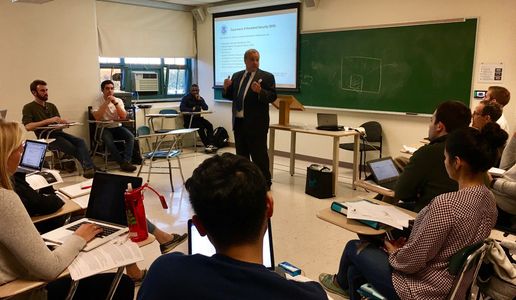Former BPD and FBI Official Discusses Biometrics with Pardee Students

A former Boston Police Department and Federal Bureau of Investigation official spoke to students at the Frederick S. Pardee School of Global Studies at Boston University about how FBI databases are used to help authorities identify individuals.
William M. Casey, a former Deputy Superintendent of the Boston Police Department and former senior official at the FBI’s Criminal Justice Information Services Division, spoke to students at the Pardee School on October 12, 2016 in “Intelligence and Homeland Security,” a graduate course taught by Professor of the Practice of International Relations John D. Woodward, Jr.
Casey, a biometrics expert, discussed his work at the FBI’s Biometric Center of Excellence and the FBI’s Next Generation Identification (NGI) system, explaining that NGI performs approximately 100,000 fingerprint searches per day and 98% of these fingerprint searches are processed in less than one hour. This efficiency allows officers to quickly run fingerprints through the FBI’s database to search for a match, indicating a prior criminal record. He contrasted this speed with his early days in Boston law enforcement in the 1980s when it would take months to perform a manual match. Under his leadership, the Boston Police Department became the first department in the United States to electronically submit fingerprints to the FBI in 1998.
Casey also discussed issues with fingerprints, noting efforts made by individuals, dating back to 1930’s criminal John Dillinger, to alter their fingerprints. More recently, individuals have attempted to alter their fingerprints surgically.
In addition, Casey discussed emerging Rapid DNA technology which he believes will significantly transform how law enforcement officers collect and use DNA and help clear DNA backlogs.